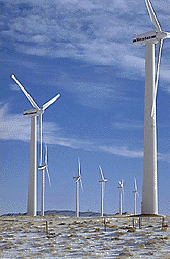Medicine Bow Wind Project
Q: Can
I buy wind energy from the Medicine Bow Wind Project?
A: Not
directly. Platte River is a community-owned, wholesale power
supplier to the communities of Estes Park, Fort Collins, Longmont
and Loveland, Colorado. You
can sign up for wind power in any of these communities, and the
wind energy you receive will come from Platte River's renewable
energy portfolio.
Q: If I sign
up to buy wind power, how can I be sure the electricity I use
actually comes from wind turbines?
A: All
the energy produced at the Medicine Bow Wind Project goes directly
into the western U.S. electric
grid, just like energy produced at any other power plant. Since
electricity follows the path of least resistance, it's difficult
to say exactly where this energy flows after it enters the grid.
However, when a customer signs up to buy a certain amount of wind
power, that much wind energy is put into the grid for that customer,
displacing energy that would have been produced at some other kind
of power plant.
Q: If I'm
a wind power customer, can I still use electricity when the wind
isn't blowing?
A: Yes.
Platte River uses its other generation resources (hydroelectric,
natural
gas and
coal-fired
power plants) to "back-up" our wind resource so customers
can use the energy when they need it, not just when the wind blows.
In general, we produce more wind energy than people use during
the winter, and less than people use during the summer. Over the
course of a year, the amount of wind energy produced balances with
the amount people use.
Q: I've read
that there's enough wind in just a few states, including Wyoming,
to supply all the electricity for the whole country. Why don't
we build more turbines so we can get all our electricity from
wind?
A: While
it is theoretically possible to produce enough energy from wind turbines
to supply
all our needs,
it's not technically feasible at present. This is because wind
is an "intermittent" resource, i.e., the wind doesn't
blow all the time. Since electricity can't be stored in large amounts,
we still need other resources to ensure that energy is available
when people need to use it. Research continues on the effect of
wind generation on electric system reliability. A recent study
of California wind farms found that wind can make up as much as
10% of total electricity capacity without significantly
impacting the reliability of the electric grid. The National Renewable
Energy Laboratory is currently conducting studies of the benefits
of geographically dispersed wind facilities on system reliability.
In addition, future developments in energy storage technologies
could greatly improve our ability to make better use of the area's
abundant wind resource.
Q: How many
turbines could eventually be added at the Medicine Bow Wind Project?
A: There
is enough land at the project to accommodate approximately 30 to
100 wind turbines, depending
on size. However, there are transmission constraints in the area
that need to be addressed before the site can be developed much
further. It may be possible to add another three to 10 turbines
before changes to the existing transmission infrastructure are
required.
Q: Why does
wind energy cost more?
A: The "fuel" for
wind turbines is free. The cost of wind energy is determined by
the
cost of buying, constructing, and maintaining the wind turbines;
transmission and distribution costs to bring the energy to the
point of use; and the cost of leasing and maintaining the land
at the Medicine Bow Wind Project site. Altogether, this cost is
still slightly higher than the cost of the other resources Platte
River uses to generate electricity. The good news is that the cost
of wind energy has dropped by about 80% over the past twenty years,
and projections are that it will continue to go down as turbines
are made more efficient and manufacturing costs continue to be
reduced.
Q: Do wind
turbines harm birds?
A: Early
generation wind farms did cause an increase in avian deaths, particularly
raptors. Newer
wind farms are sited to avoid avian migration routes, and new generation
wind turbines are designed with tubular towers, to eliminate perching
and nesting sites for birds, and blades that turn slower to make
them easier for birds to see. The Medicine Bow Wind Project is
not near any avian migration routes, and studies conducted at the
site have shown that turbine operation has minimal impact to birds
in the area.

